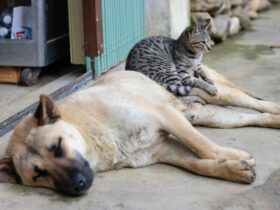Introduction
Choosing a pet is a big decision that can significantly impact your lifestyle. Cats and dogs are the most popular pets worldwide, each with unique traits, behaviors, and care requirements. Whether you’re looking for a playful companion, a low-maintenance friend, or a loyal guardian, understanding the differences between cats and dogs can help you decide which pet is best for you. In this blog, we’ll compare the benefits and challenges of owning cats versus dogs, so you can determine which pet aligns better with your lifestyle.
1. Temperament and Personality
Cats: Independent and Mysterious
- Independence: Cats are known for their independent nature. They often enjoy their own company and can be left alone for longer periods than dogs. This makes them ideal for people with busy schedules or those who work long hours.
- Curiosity: Cats are naturally curious and enjoy exploring their environment. They tend to be more reserved and can take time to warm up to new people. However, once they trust you, they can be incredibly affectionate and loyal.
- Low Maintenance: Generally, cats are more low-maintenance than dogs. They don’t require constant attention and are content with minimal interaction, as long as they have food, water, and a comfortable place to sleep.
Dogs: Loyal and Social Companions
- Social Nature: Dogs are social animals that thrive on companionship and interaction. They often view their owners as part of their pack and enjoy spending time with them. This makes them great for families, active individuals, or those looking for a constant companion.
- Variety in Temperament: Dog breeds vary widely in temperament, from the energetic Border Collie to the laid-back Bulldog. This diversity allows potential owners to choose a dog that matches their personality and lifestyle.
- Need for Attention: Unlike cats, dogs require more attention and can become anxious or destructive if left alone for too long. They thrive on human interaction, regular exercise, and mental stimulation.
2. Space and Living Arrangements
Cats: Adaptable to Smaller Spaces
- Ideal for Apartments: Cats are generally well-suited to apartment living or smaller homes. They don’t need a yard to roam and can be content indoors as long as they have space to climb, scratch, and play.
- Less Space-Dependent: Cats can adapt to a variety of living conditions. They do not need a large area to exercise and are usually happy with a cozy corner or a perch by a window.
- Quiet and Discreet: Cats are typically quieter than dogs and less likely to disturb neighbors. This makes them a good choice for those living in close quarters or apartments with noise restrictions.
Dogs: Need for Space and Activity
- Active and Energetic: Many dog breeds require ample space to run and play. If you have a backyard or live near a park, a dog might be a better fit for you, especially if you enjoy outdoor activities.
- Size Considerations: The size of your living space can significantly impact the type of dog that suits you. Larger breeds may need more room to move around, while smaller breeds can adapt better to apartment living.
- Exercise Requirements: Dogs need regular exercise to stay healthy and happy. This can range from short walks for smaller breeds to extensive playtime and running for more energetic breeds.
3. Time Commitment and Lifestyle
Cats: Suited for Busy or Low-Key Lifestyles
- Less Time-Consuming: Cats generally require less time and effort than dogs. They don’t need to be walked, and their grooming needs are usually minimal compared to some dog breeds.
- Low-Key Companions: If you prefer a more relaxed lifestyle or don’t have much time to dedicate to a pet, a cat might be a better fit. They are more independent and can entertain themselves with toys or by exploring their environment.
- Self-Sufficient: Cats are largely self-sufficient. They use a litter box and groom themselves, which reduces the amount of direct care they require.
Dogs: Best for Active and Social Lifestyles
- Active Engagement: If you lead an active lifestyle, enjoy outdoor activities, or are looking for a pet that will encourage you to be more active, a dog can be a great companion. Dogs love walking, running, and playing fetch, which can be great ways to stay fit and healthy.
- Routine and Structure: Dogs thrive on routine and require regular feeding, walking, and playtime. If you enjoy structure and have the time to commit to a pet’s needs, a dog could be an excellent choice.
- Social Interaction: Dogs often encourage more social interaction. Walking a dog can lead to meeting new people and becoming part of a community, which can be a benefit for those who enjoy being social.
4. Maintenance and Care
Cats: Lower Maintenance, Less Frequent Grooming
- Self-Grooming: Cats are meticulous groomers and usually take care of their cleanliness. While some long-haired breeds may require occasional brushing, most cats are low-maintenance in terms of grooming.
- Litter Training: Cats use litter boxes, which means you don’t need to take them outside for bathroom breaks. This can be a significant advantage in terms of convenience, especially for people who are not home often.
- Medical Care: Cats generally require fewer vet visits than dogs, but they are prone to specific health issues such as urinary tract problems and dental issues. Regular check-ups are still essential to ensure their health.
Dogs: Higher Maintenance and Grooming Needs
- Grooming Requirements: Dogs’ grooming needs vary greatly depending on the breed. Long-haired breeds may require regular grooming sessions, while short-haired breeds may only need occasional brushing.
- Exercise and Training: Dogs need regular exercise and training to stay healthy and well-behaved. This requires a significant time commitment and can include daily walks, playtime, and training sessions.
- Medical Care: Dogs are generally more prone to certain health issues, such as hip dysplasia or allergies, depending on the breed. They also need vaccinations, flea prevention, and regular vet check-ups to stay healthy.
5. Costs of Ownership
Cats: Lower Initial and Ongoing Costs
- Lower Upfront Costs: Adopting a cat is often less expensive than adopting a dog. Cats generally require fewer initial supplies, such as a litter box, scratching post, and a few toys.
- Food and Care Costs: Cats typically eat less than dogs, resulting in lower food costs. Additionally, their grooming and veterinary care tend to be less expensive, especially if they are indoor-only cats.
- Less Frequent Expenses: Because cats are more independent and don’t need as many accessories or services (like walking or grooming), the ongoing costs of owning a cat are often lower.
Dogs: Higher Costs, More Supplies Needed
- Higher Initial Investment: Owning a dog usually involves higher upfront costs, including vaccinations, spaying/neutering, a bed, toys, a leash, and more.
- Food and Care Costs: Depending on the size and breed, dogs can be more expensive to feed. Larger breeds consume more food, and certain breeds may require specialized diets.
- Additional Services: Dogs may need additional services, such as professional grooming, training, or boarding, which can add to the cost of ownership.
6. Allergies and Cleanliness
Cats: Potential Allergens and Maintenance
- Allergy Concerns: Cat allergies are relatively common due to the dander they produce. However, some people find they can tolerate certain breeds better than others, such as hypoallergenic breeds like the Siberian or Balinese.
- Litter Box Maintenance: While cats are clean animals, their litter boxes require regular cleaning to prevent odors and maintain hygiene. This can be a downside for people who prefer minimal pet maintenance.
Dogs: More Clean-Up, Possible Allergies
- Shedding and Allergies: Many dogs shed, which can be a problem for people with allergies. However, some breeds are considered hypoallergenic, such as the Poodle or the Bichon Frise, which may be suitable for allergy sufferers.
- Cleanliness: Dogs can be messier than cats, especially if they enjoy rolling in mud or swimming. Regular baths and grooming can help keep them clean, but this adds to the maintenance workload.
7. Emotional Connection and Companionship
Cats: Subtle Affection and Independence
- Bonding with Cats: Cats are known for their subtle ways of showing affection. They may rub against you, purr, or sit near you to show they care. This can create a deep bond for those who appreciate a more understated form of companionship.
- Emotional Independence: Cats are emotionally independent and do not require constant attention, making them ideal for people who prefer a pet that is not overly dependent on them.
Dogs: Strong Bonds and Emotional Support
- Loyal Companionship: Dogs are often described as “man’s best friend” for a reason. They form strong bonds with their owners and are known for their loyalty and affection.
- Emotional Support: Dogs can provide significant emotional support and comfort, making them ideal for people seeking a pet that offers companionship and emotional connection. They are often used as therapy or service animals due to their ability to connect deeply with humans.
Conclusion
Choosing between a cat and a dog depends largely on your lifestyle, preferences, and what you’re looking for in a pet. Cats offer independence, low-maintenance care, and adaptability, making them great for busy or low-key individuals. Dogs provide loyalty, active companionship, and emotional support, ideal for those who enjoy a more engaging and interactive relationship with their pet. By understanding the differences in temperament, care needs, and lifestyle compatibility, you can make an informed decision about which pet is better suited for you.











Leave a Reply